 W
WThe Adolph Block is a historic commercial building located in downtown Salem, Oregon, United States. It was constructed in 1880 by German immigrant and pioneering Salem brewer Samuel Adolph (1835-1893), who purchased the property that Summer after a fire had destroyed the previous wooden buildings on the site. It was designed and built by Salem contractor J.S. Coulter. Completed by the end of the year, It was built sharing party walls with the adjoining J. K. Gill Building (1868) to the West and the long-since demolished Gray's Block on the East, of which one cast iron column remains. Though altered many times over the past century, the Adolph Block still retains many distinctive Italianate details and is one of the finer remaining examples of the style in Salem's downtown historic district.
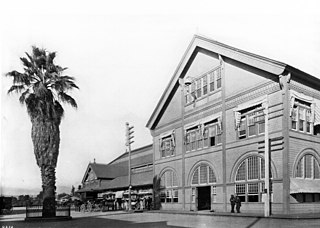 W
WThe Arcade Depot was the main Southern Pacific Railroad passenger railway station, from 1888 until 1914. It was located on Alameda Street, between 5th and 6th Streets, in Los Angeles, California.
 W
WThe Barnes Building, originally known as the Odd Fellows' Block, the Masonic Temple from 1909 to 1915, and later Ingram Hall, is a historic fraternal and office building located at 2320-2322 1st Avenue in the Belltown neighborhood of Seattle, Washington. Designed in early 1889 and constructed in late 1890 by Seattle Lodge No. 7 of the International Order of Odd Fellows and designed for use by all of the city's Odd Fellow lodges, it is the earliest known surviving work of Seattle architect William E. Boone and George Meeker and remains in an almost perfect state of preservation. The Barnes building has played an important role in the Belltown Community and Seattle's dance community. It was used by the Odd Fellows for 17 years before their departure to a newer, bigger hall in 1909 and was home to a variety of fraternal & secret societies throughout the early 20th century, with the Free and Accepted Masons being the primary tenant until their own Hall was built in 1915. The ground floor has been a host to a variety of tenants since 1890 ranging from furniture sales to dry goods to farm implement sales and sleeping bag manufacturing, most recently being home to several bars. It was added to the National Register of Historic Places as The Barnes Building on February 24, 1975.
 W
WThe Bell Apartments, also known as the Austin A. Bell Building is a historic building located at 2326 1st Avenue in the Belltown neighborhood of Seattle Washington. The building was named for Austin Americus Bell, son of one of Seattle's earliest pioneers, but built under the supervision of his wife Eva following Bell's unexpected suicide in 1889 soon after proposing the building. It was designed with a mix of Richardsonian, Gothic and Italianate design elements by notable northwest architect, Elmer Fisher, who designed many of Seattle's commercial buildings following the Great Seattle fire.
 W
WThe Century Building is a Queen Anne style building at 33 East 17th Street between Park Avenue South and Broadway in Union Square, Manhattan, New York City. It was designed by William Schickel and built in 1880–1881 by Arnold Constable & Company. The Century Building consists of five floors topped by a 1 1⁄2-story attic.
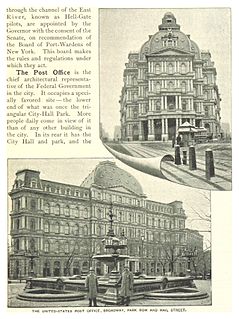 W
WThe City Hall Post Office and Courthouse was designed by architect Alfred B. Mullett for a triangular site in New York City along Broadway in Civic Center, Lower Manhattan, in City Hall Park south of New York City Hall. The Second Empire style building, erected between 1869 and 1880, was not well received. Commonly called "Mullett's Monstrosity", it was demolished in 1939 and the site used to extend City Hall Park to the south.
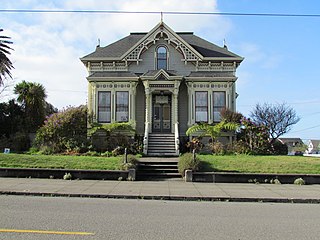 W
WThe William S. Clark House, in Eureka, Humboldt County, northern California was built in 1888 by master carpenter Fred B. Butterfield. Its design includes elements of both Stick-Eastlake and Queen Anne Styles of Victorian architecture.
 W
WThe Corvallis Arts Center is a nonprofit organization whose stated mission includes conducting an array of "diverse exhibitions and cultural events" and providing the Corvallis, Oregon community with outreach and educational services relating to the arts. The center offers an ongoing series of art classes and camps, with a particular focus on the needs of at-risk youth. More than a dozen teaching artists working in a range of mediums conduct classes, exhibits, and demonstrations in connection with the center's work.
 W
WThe James H. Dodson Residence is a Los Angeles Historic-Cultural Monument located in the San Pedro community of Los Angeles, California, near the Port of Los Angeles.
 W
WThe Eden Park Station No. 7 is a historic structure located in Eden Park in Cincinnati, Ohio, United States. Constructed in the late nineteenth century as a significant part of the city water supply system, it was used for its original purpose for only a few decades. As a work of Cincinnati's most important architect, it has been named a historic site.
 W
WEly Hall is a two-story Richardsonian Romanesque classroom and laboratory building on the campus of Vassar College in the town of Poughkeepsie, New York, US. The structure houses Vassar's Department of Earth Science and Geography, the A. Scott Warthin, Jr. Museum of Geology and Natural History, and the Aula, a spacious and frequently used gathering space.
 W
WThe William English House is a historic farmhouse in the far western portion of the U.S. state of Ohio. Located along State Route 47 northeast of the village of Versailles in the northeastern corner of Darke County, the house was built in 1881 as the residence of William English, an astronomically-inclined farmer. English was a native of Ireland who immigrated to the United States in 1823. Besides farming, English operated a brickworks on his property, and his employees generally lived in the same house as his family. Consequently, the house is significantly larger than was necessary for the family members alone.
 W
WThe Four Houses by Architect Frederick Schock are Queen Anne and Shingle styles houses located at 5749 & 5804 West Race Avenue and 5804 & 5810 West Midway Park in the Austin neighborhood of Chicago, Illinois, United States. The houses were built between 1886 and 1892 by Frederick R. Schock. They were designated Chicago Landmarks on January 20, 1999.
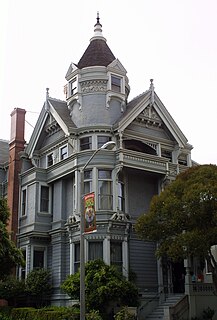 W
WThe Haas–Lilienthal House is a historic building located at 2007 Franklin Street in San Francisco, California, United States, within the Pacific Heights neighborhood. Built in 1886 for William and Bertha Haas, it survived the 1906 San Francisco earthquake and subsequent fire. The house is a San Francisco Designated Landmark and is listed on the U.S. National Register of Historic Places. It is the city's only intact Victorian era home that is open regularly as a museum, complete with period furniture and artifacts. As of 2016, it received over 6,500 visitors annually.
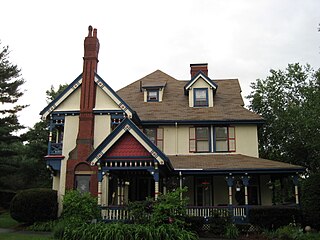 W
WThe Henry Bradlee Junior House is located in Medford, Massachusetts. It was designed in the Queen Anne style by Peabody & Stearns circa 1881–1882. This was one of three houses built by the Halls and the Bradlees on their estate.
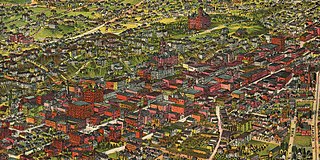 W
WThe late-Victorian-era Downtown of Los Angeles grew year by year, around 1880 centered at the southern end of the Los Angeles Plaza area, and over the next two decades, extending south and west along Main Street, Spring Street, and Broadway towards Third Street. Most of the 19th-century buildings no longer exist, surviving only in the Plaza area or south of Second Street. The rest were demolished to make way for the Civic Center district with City Hall, numerous courthouses, and other municipal, county, state and federal buildings, and Times Mirror Square. This article covers that area, between the Plaza, 3rd St., Los Angeles St., and Broadway, during the period 1880 through the period of demolition (1920s–1950s).
 W
WThe late-Victorian-era Downtown of Los Angeles grew year by year, around 1880 centered at the southern end of the Los Angeles Plaza area, and over the next two decades, extending south and west along Main Street, Spring Street, and Broadway towards Third Street. Most of the 19th-century buildings no longer exist, surviving only in the Plaza area or south of Second Street. The rest were demolished to make way for the Civic Center district with City Hall, numerous courthouses, and other municipal, county, state and federal buildings, and Times Mirror Square. This article covers that area, between the Plaza, 3rd St., Los Angeles St., and Broadway, during the period 1880 through the period of demolition (1920s–1950s).
 W
WThe Cotton Exchange Building is a historic building located in downtown Houston. Built in 1884, it is listed on the National Register of Historic Places. The Houston Cotton Exchange and Board of Trade commissioned local architect Eugene Heiner to design a three-story building on Travis Street at the corner of Franklin in Houston. In 1907, the building was remodeled and a fourth floor added. The Houston Cotton Exchange continued to use the building until it moved its operations to a new building several blocks away at Prairie and Caroline in 1924.
 W
WThe Hull Building is a historic commercial building located at 2401-2405 1st Avenue in the Belltown neighborhood of Seattle, Washington. Designed by notable Northwest architect Elmer Fisher, It was constructed in the latter half of 1889 as an investment property by Seattle politician Alonzo Hull (1843-1929), and was added to the National Register of Historic Places on January 27, 1983. It is adjacent to the Battery Street Tunnel's south portal.
 W
WJulius' Castle is a castle-shaped building that sits at 1541 Montgomery Street on Telegraph Hill in San Francisco. It served as a visual landmark and as a restaurant for many years, originally opening between 1924 and 1928. Since 1980, the building has been listed as a San Francisco Landmark Number 121. The architecture is described by the San Francisco Planning Department as, "primarily derived from the Gothic Revival and Arts & Crafts Styles".
 W
WThe Lambert-Parent House is a historic house in the village of Union City, Ohio, United States. Built in 1881, it was initially the home of George Lambert, who founded multiple major businesses in Union City and participated in the automobile manufacturing firm founded by his brother John. Built of brick on a stone foundation and topped with a slate roof, it is a fine example of the Italianate style of architecture and one of the most prominent structures in Union City. Among its most distinctive architectural elements are its ornate cornices and its tall, narrow windows.
 W
WThe Market Street Row is located on the west side of that street in Poughkeepsie, New York, United States, just south of Hulme Park and across from the Adriance Memorial Library, on the southern edge of downtown. It includes three houses, including the Mott-Van Kleeck House, the oldest frame house in the city.
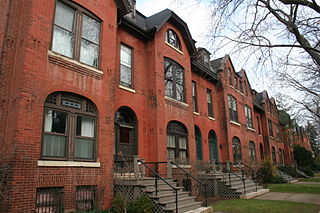 W
WThe McCormick Row House District is a group of houses located in the Lincoln Park community area in Chicago, Illinois, USA. It sits between East and West parts of DePaul University's Lincoln Park Campus and is independent from the school. They were built between 1884 and 1889 and used by the McCormick Theological Seminary to gain rental income. They were designed in the Queen Anne Style by the A. M. F. Colton and Son architects and joined the list of Chicago Landmarks May 4, 1971. The McCormick Row House District also lies within the boundaries of the Sheffield Historic District.
 W
WMilwaukee Soldiers Home is one of three Soldiers homes which have survived in the United States. It was built for the rehabilitation of Civil War soldiers. The building recognized as a National Historic Landmark District property. There are a total of 24 other buildings on the grounds which are also part of the Northwestern Branch, National Home for Disabled Volunteer Soldiers Historic District.
 W
WThe Mount Tabor Methodist Episcopal Church is a historic church building located along State Route 245 near West Liberty in Salem Township, Champaign County, Ohio, United States. Built in 1881 in the Gothic Revival style of architecture, it served a congregation formed in the 1810s. This congregation of the Methodist Episcopal Church worshipped in at least three different buildings before its closure.
 W
WThe John Muir National Historic Site is located in the San Francisco Bay Area, in Martinez, Contra Costa County, California. It preserves the 14-room Italianate Victorian mansion where the naturalist and writer John Muir lived, as well as a nearby 325-acre tract of native oak woodlands and grasslands historically owned by the Muir family. The main site is on the edge of town, in the shadow of State Route 4, also known as the "John Muir Parkway."
 W
WThe former Nast Trinity United Methodist Church, now known as The Warehouse Church, is a historic congregation of the United Methodist Church in Cincinnati, Ohio, United States. Designed by leading Cincinnati architect Samuel Hannaford and completed in 1880, it was the home of the first German Methodist church to be established anywhere in the world, and it was declared a historic site in the late twentieth century.
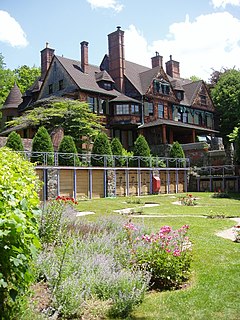 W
WNaumkeag is the former country estate of noted New York City lawyer Joseph Hodges Choate and Caroline Dutcher Sterling Choate, located at 5 Prospect Hill Road, Stockbridge, Massachusetts. The estate's centerpiece is a 44-room, Shingle Style country house designed principally by Stanford White of McKim, Mead & White, and constructed in 1886 and 1887.
 W
WPalo Alto Stock Farm Horse Barn, also known as Stanford Red Barn or Stanford Stables, is located at present-day address 100 Electioneer Road in Stanford, California. This barn was established c.1878-1880 and is an example of Victorian-era Stick-Eastlake style architecture, though the architect is unknown. Palo Alto Stock Farm Horse Barn has been listed on the National Register of Historic Places since 1985. There are only two original buildings left from the Palo Alto Stock Farm: the red barn and the brick stable.
 W
WThe Peter Kirk Building, first known as the Kirkland Investment Company Building, is a historic building in Kirkland, Washington located at the corner of Market Street and Seventh Avenue, Kirkland's historic commercial core. It is listed on the National Register of Historic Places. It was built in 1889 by the city's founder and namesake Peter Kirk, who constructed the building as the intended centerpiece of his planned steel producing mecca until those plans were dashed by multiple factors including the Panic of 1893. In the ensuing years, Kirkland's commercial core shifted to the south, likely sparing the building the fate of urban renewal or being altered beyond recognition. Due to its location on the East Side's main north-south arterial the building remained occupied on the ground floor but had fallen into serious disrepair by the mid-20th century. The building was rescued from demolition in the early 1960s by a syndicate led by William Radcliffe who purchased and restored the Peter Kirk Building into the Kirkland Arts Center which it remains to the current day. Today it is one of Kirkland's most historic and iconic landmarks.
 W
WThe Abner Phelps House is currently the oldest house in San Francisco, constructed in approximately 1850 by Abner Phelps and his wife Augusta Roussell with pre-constructed house parts. It is located at 1111 Oak Street just west of Divisadero Street in San Francisco's Haight Ashbury district. The home is listed on the National Register of Historic Places and is San Francisco Landmark Number 32, since 1979. The house is not open to the public and as of 2019 is the location of a private business.
 W
WPilgrim Presbyterian Church is a historic church building in the Mount Adams neighborhood of Cincinnati, Ohio, United States, near the Ida Street Viaduct. Built in 1886, it is a Gothic Revival structure built primarily of brick. Constructed by Mount Adams architect and builder Charles E. Iliff, the church features a two-story rectangular floor plan with a prominent central bell tower. Among its other distinctive architectural elements are the rose windows in the main gable, pairs of windows on its second floor, and the symmetry evidenced in the overall design of the building.
 W
WPullman National Monument, also known as The Pullman District and Pullman Historic District, is located in Chicago and was the first model, planned industrial community in the United States. The district had its origins in the manufacturing plans and organization of the Pullman Company, and became one of the most famous company towns in the United States, as well as the scene of the violent 1894 Pullman strike. It was built for George Pullman as a place to produce the famous Pullman sleeping cars.
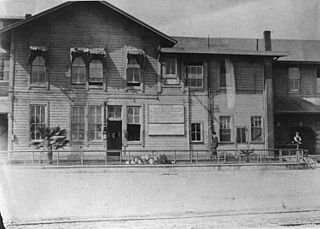 W
WRiver Station was a Southern Pacific Railroad passenger station location, southwest of the Los Angeles River on San Fernando Road and north of Downtown, in Los Angeles, California. The site is within the present day Los Angeles State Historic Park.
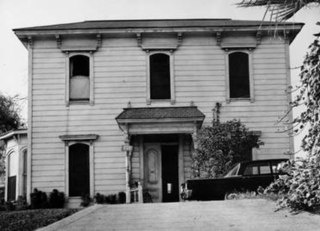 W
WThe Salt Box was a house built in the 1880s in the Bunker Hill section of Los Angeles, California. Designed in the saltbox style that was popularized in New England, it was originally located at 339 South Bunker Hill Avenue. In the late 19th century, Bunker Hill was one of the most prestigious neighborhoods in Los Angeles and was the site of many elegant Victorian homes. The Los Angeles Times wrote of old Bunker Hill: "Nowhere else in Los Angeles was the architecture so ornate. The mansions were wooden-frame Victorian with Gothic gingerbread touches applied with a heavy hand to simulate masonry." Though not as elegant as many of its Victorian neighbors, the Salt Box was "cherished by architecture students for the simplicity of its design."
 W
WThe Seven Houses on Lake Shore Drive District is a historic district in Chicago, Illinois, United States. The district was built between 1889 and 1917 by various architects including Benjamin Marshall, Holabird & Roche, Howard Van Doren Shaw, and McKim, Mead & White. It was designated a Chicago Landmark on June 28, 1989.
 W
WThe Ward House is a house on Capitol Hill in Seattle, Washington, USA. Having been built in 1882, it is one of the oldest houses in Seattle. Existing houses reportedly built before 1882 in Seattle include the 2629 East Aloha Street (1881), 727 28th Avenue (1870) and Maynard's House located at 3045 64th Avenue Southwest.
 W
WWard Memorial Hall is an 1880s theater building within the Northwestern Branch, National Home for Disabled Volunteer Soldiers Historic District, located in Milwaukee, Wisconsin. It is part of the Milwaukee Soldiers Home complex, designated Building No. 41, on the present day Clement J. Zablocki VA Medical Center grounds.
 W
WThe William Westerfeld House is a historic building located at 1198 Fulton Street in San Francisco, California, United States, across the street from the northwest corner of Alamo Square. Constructed for German-born confectioner William Westerfeld in 1889, the home is listed on the National Register of Historic Places and is San Francisco Landmark Number 135.
 W
WThe Wigman House is a historic American Queen Anne house in the Carrick neighborhood of Pittsburgh, Pennsylvania. It is a City of Pittsburgh Designated Historic Structure.